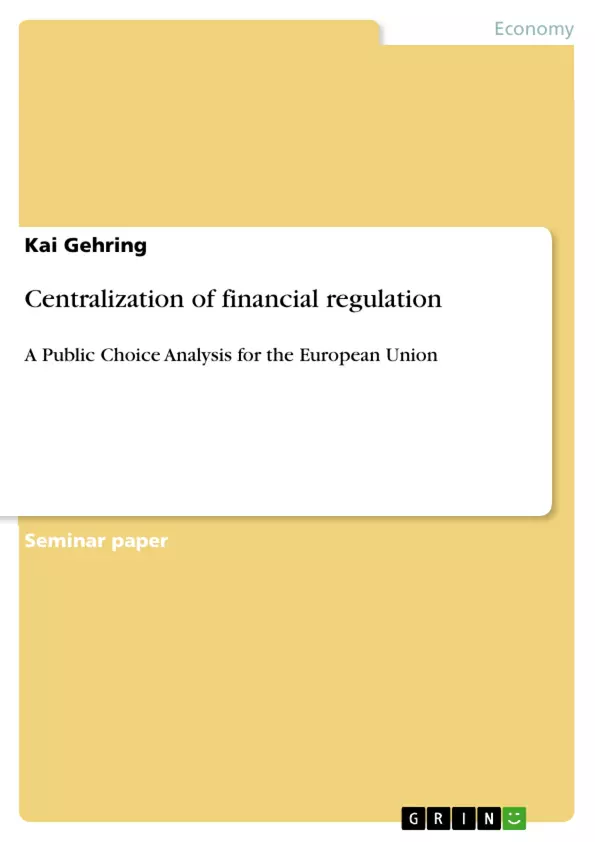Financial regulation has played an unfavorable role in the financial crisis. Many reform proposals conclude from its failure that there is a need for more and tougher rules (Group G30 2009).Consolidating existing regulatory bodies and a centralization of authorities seem to be the ubiquitous answer of many politicians. In the European Union (EU), a reform proposal has gained support by the European parliament (EP) and the European Commission (EC), which would mean additional competences and staff for European bureaucracies. Because it would centralize large parts of regulation and supervision, political arguments focus on the allocation of competences and power. However, it is not sure if the proposed changes would have any effect in preventing future crises.
The structure of this paper follows a systematic approach to demonstrate problems with this proposal. At first, I show in chapter 2 that the role of regulation and governments in the financial crisis is ambiguous. What is viewed as market failure was sometimes only a rational response to
incentives set by regulation. It is often stated that markets did not work efficiently, and the obvious solution is to rely on governments and regulators to fix the problems. I check if international comparison provides support for consolidating regulatory bodies. In Chapter 3, I assess in detail the
proposed EU reform that focuses on establishing new bureaucracies and implementing more rules. I will use a structured Public Choice approach to evaluate the reform proposal and assess special interests of involved political parties. Chapter 4 examines the role of the EU Council and voter
preferences. Considerable power in the EU decision-making process rests with parties that support centralization and more regulation. With various approaches, it is tried to shed light on the position of the Council as the representation of member states. While European institutions might embrace
additional power and competences, rational voters in the member states should oppose harmful, excessive regulation and centralization. However, a detailed analysis of government and voter preferences reveals that both are likely to have biased preferences in favor of too much regulation.
Inhaltsverzeichnis (Table of Contents)
- Introduction
- Financial Regulation
- Kinds of regulation
- Regulatory competition
- The dilemma of regulation
- The role of regulation in the recent financial crisis
- Regulation, incentives and amplifying effects
- Consolidation
- Regulatory approaches
- International comparison
- Centralizing regulation and supervision in Europe
- EU institutions and positions
- Subsidiarity in the EU treaties
- Interests for centralization
- Reform Proposals for the EU
- Public Choice Analysis
- Policy uniformity
- Leviathan
- Lobbying
- Policy learning
- Complementarities
- Decision making
- The role of the EC and the ECB
- EU institutions and positions
- The Council, Voters opinion and the risk of over-regulation
- The Council and the political decision-making process
- Decision making on EU level
- Description of data
- Application to EU Council decision-making
- Voter Irrationality and the risk of over-regulation
- The Council and the political decision-making process
- Conclusion
Zielsetzung und Themenschwerpunkte (Objectives and Key Themes)
This seminar paper examines the implications of centralizing financial regulation within the European Union, using a Public Choice approach. The paper analyzes whether the proposed centralization of regulatory powers would effectively prevent future financial crises. The main focus lies on evaluating the efficiency of increased regulation and the potential for overregulation.- The role of regulation in the recent financial crisis
- The impact of consolidation and centralization on financial regulation
- The influence of Public Choice factors on regulatory decision-making
- The potential for overregulation and its consequences
- The importance of transparency and public disclosure of information
Zusammenfassung der Kapitel (Chapter Summaries)
- Introduction: This chapter introduces the topic of financial regulation and its role in the recent financial crisis. It highlights the debate surrounding the need for more and tougher regulations, and focuses on the proposed EU reform that aims to centralize regulatory powers.
- Financial Regulation: This chapter explores different types of financial regulation, including regulatory competition and the dilemma of regulation. It examines the role of regulation in the recent financial crisis, including the relationship between regulation, incentives, and amplifying effects. It also discusses the concept of consolidation and different regulatory approaches.
- Centralizing regulation and supervision in Europe: This chapter analyzes the proposed EU reform, focusing on the establishment of new bureaucracies and implementation of additional rules. It examines EU institutions and positions, including the principle of subsidiarity and the motivations behind centralization. The chapter further utilizes a structured Public Choice approach to evaluate the reform proposal and assess the interests of involved political parties.
- The Council, Voters opinion and the risk of over-regulation: This chapter investigates the role of the EU Council in the decision-making process and analyzes voter preferences regarding regulation. It examines the potential for overregulation and explores factors that influence the Council's position on regulatory issues.
Schlüsselwörter (Keywords)
The key concepts explored in this paper include financial regulation, centralisation, European Union, Public Choice, overregulation, decision-making, voter preferences, transparency, and the financial crisis. The paper investigates the interplay of these factors in shaping the regulatory landscape of the European Union.- Quote paper
- Kai Gehring (Author), 2010, Centralization of financial regulation , Munich, GRIN Verlag, https://www.grin.com/document/165291



